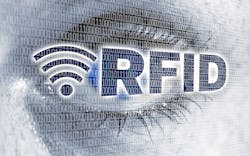Evolution of identification technology: From barcodes to RFID and beyond
We, as humans, can talk and gesture, but a bag of peas cannot. So, when two Drexel University students went looking for a method of providing better inventory management for grocery stores, as well as a better customer checkout experience, the barcode was born.
Now the bag of peas had a name that could be recognized by a static object called a barcode reader. Oops, there really wasn’t one back in those days that could actually work as far as the design of the circular barcode helping a supermarket create a self-checkout line.
It really wasn’t until the 1970s that an oscillating mirror laser could read barcodes and interface into the inventory system along with the development of the vertical UPC code that we know and love.
The first scan of a pack of gum took place in 1974. What the checkout system needed to know was the product code, which was set up in a database so the pricing and other pieces of information tagged to that pack of gum could be accessed.
Voila! The receipt was printed, money exchanged, and the customer left the building.
Any sort of code essentially does the same thing—identify.
The limitation comes from the form factor of the code. A bag of peas from Del Monte vs. Green Giant would have different price points, bag size, vendor name, store SKU, and maybe even large vs. small peas. The barcode to be read would be very long.
Do we really need that capability on the code itself? Not if we have access to a database that can be pointed into and grab all that data in an instant.
Access to information has always been the holy grail. The :CueCat device was issued by Radio Shack—for free, I might add—to read a barcode beside an ad in a magazine, which by all accounts led you to a web page that advertised that product or technology.
Quick-response (QR) codes are an extension of the barcode technology, but they give the ability of alphanumeric data that can be scanned. This will become very handy when scanning with a smartphone to access a URL to get to a webpage on the internet in a restaurant so you can see the menu. It was 1974 when this code was created. Readers were clumsy at best. The QR code currently in use was developed in 1999 in Japan.
Radio-frequency identification (RFID) systems are similar to barcodes in that they identify. That bag of peas could, in the modern era, actually have an RFID tag in or on the bag. Radio-frequency identification devices come in different flavors—passive and active.
One of the main differences in coding techniques is destructive vs. non-destructive programming. Barcodes that are printed onto a product or device are there forever and cannot be changed—destructive.
Radio-frequency identification tags can be repurposed and thus reprogrammed, which is non-destructive. The data is associated with an RFID tag. The application determines the extent of the programming.
A passive tag needs to have power induced by the reader itself, which limits the distance away from the reader. Consider your credit card that has RFID embedded, so you have to place the card right onto the reader. Also consider the fact that a criminal can have a reader in pocket and brush up against your pocket or purse and read your card, so the technology is really cool, but potentially harmful to your bank account.
Active tags have their own power supply and thus can transmit signals with higher power, so the reader can be farther away.
A project that I was involved with tracked carts in a distribution warehouse. The cart was loaded with a disparate product destined for Store A. If the truck that was destined for Store A was ready but waiting for a last batch of product, a forklift driver would know where it was and then drive by the carts to find the one, pick up the pallet and deliver it to the truck for efficiency.
Once the product was shipped, the tag would be reset to default, ready to be used again.
Radio-frequency identification allows any operation to be dynamic with the movement of equipment and/or stock. We are getting closer to the ability to have all data that used to be in a database be resident in the tag itself. Power requirements are getting smaller. Distances to be read are increasing.
There’s no telling where identification technology will end up.
About the Author

Jeremy Pollard
CET
Jeremy Pollard, CET, has been writing about technology and software issues for many years. Pollard has been involved in control system programming and training for more than 25 years.

Leaders relevant to this article:
